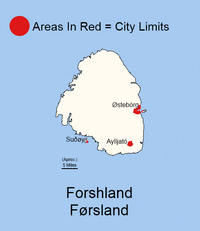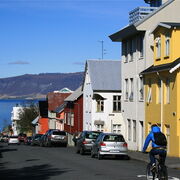Booleanbull (talk | contribs) No edit summary |
Booleanbull (talk | contribs) No edit summary |
||
| (2 intermediate revisions by the same user not shown) | |||
| Line 53: | Line 53: | ||
[[File:Ms_hq_østebórg.jpg|thumb|left|Microsoft HQ in Østebórg.]]The economy of Forshland is based heavily off of the fishing industry. Since it's a remote island there's not many international manufacturing businesses. The economy is also heavily based off of the manufacture of computer chips and other computer hardware. This helps the economy quite a bit. The unemployment rate in Forshland is fairly low (4.5%). Especially for being a remote island. The Forshlandic Krone gained value in the recent years with the introduction of major corporations to the island, and more money coming in. |
[[File:Ms_hq_østebórg.jpg|thumb|left|Microsoft HQ in Østebórg.]]The economy of Forshland is based heavily off of the fishing industry. Since it's a remote island there's not many international manufacturing businesses. The economy is also heavily based off of the manufacture of computer chips and other computer hardware. This helps the economy quite a bit. The unemployment rate in Forshland is fairly low (4.5%). Especially for being a remote island. The Forshlandic Krone gained value in the recent years with the introduction of major corporations to the island, and more money coming in. |
||
==Demographics== |
==Demographics== |
||
| + | ===Population=== |
||
Most people who live in Forshland are either ethnic Forshlanders (77%) or ethnic Norwegians (21%). The other 2% are either ethnic Icelanders, ethnic Danes, or foreigners from non-Nordic countries. |
Most people who live in Forshland are either ethnic Forshlanders (77%) or ethnic Norwegians (21%). The other 2% are either ethnic Icelanders, ethnic Danes, or foreigners from non-Nordic countries. |
||
| + | |||
| + | ===Language=== |
||
The Forshlandic language is the ''de facto'' language of Forshland. While Norwegian is also and official language, rarely is it learned as a first language except for all Norwegian households in Forshland. Forshlandic grammar is most similar to Norwegian and vocabulary is most similar to Faroese, Icelandic and to the extinct language Old Norse. In contrast, spoken Forshland is very different from Icelandic and is closer to Faroese. While Forshlandic is the main language spoken on the island, Norwegian is also an official language. |
The Forshlandic language is the ''de facto'' language of Forshland. While Norwegian is also and official language, rarely is it learned as a first language except for all Norwegian households in Forshland. Forshlandic grammar is most similar to Norwegian and vocabulary is most similar to Faroese, Icelandic and to the extinct language Old Norse. In contrast, spoken Forshland is very different from Icelandic and is closer to Faroese. While Forshlandic is the main language spoken on the island, Norwegian is also an official language. |
||
| + | |||
| + | ===Urbanization=== |
||
| + | Ever since the mid 1960s, Forshland has been developing fast. Industrialisation has been becoming more [[File:Downtown_østebórg.jpg|thumb|Downtown Østebórg.]]centralized in bigger cities like Østebórg. In recent decades, the village-based social structure has nevertheless been placed under pressure, giving way to a rise in interconnected "centres" that are better able to provide goods and services than the badly connected periphery. This means that shops and services are now relocating en masse from the villages into the centres. |
||
Latest revision as of 08:21, 21 August 2011
|
Republic of Forshland
Liðveldíg Førsland | |
|
Anthem
|
Okkar Land, So Fríða
Our Land, So Beautiful |
|
Capital and Largest City
|
|
|
Official Languages
|
Forshlandic, and Norwegian
|
|
Demonym
|
Forshlandic, Forshlander
|
|
Government
|
Parliamentary Democracy
|
|
Prime Minister
|
|
|
Currency
|
Forshlandic Krone
|

Forshland
Forshland (Førsland /fø(ɻ)ʂlɑnd/) is an island situated in the Norwegian Sea, approximately 306 miles off the coast of Frøya, Norway. Forshland is a self-governing territory. The total area is approximately 2,701 sq mi with a population of about 135,450 in 2010. The Capital and largest city of Forshland is Østebórg which means "Eastern Stronghold" in Forshlandic. Østebórg makes up about 1/3 of the population of Forshland making it the most populous town in Forshland.

Suburb of Østebórg in the Winter.
History[]
First Norse Settlements c. 935[]

A Viking settlement on the southern coast of Forshland.
The first settlements in Forshland were on the South-Eastern coast of Forshland. Norwegian Vikings stumbled upon the island and saw it as a good place to make settlements. They brought the Old Norse language with them and after time it evolved into what is modern day Forshlandic. After exploring the island for about 4 years they made a new settlement on the Eastern coast which was known then as Aust Havn "East Port". Today Aust Havn is known as Østebórg and is the largest city in Forshland.
Union with Norway 1026 - 1453[]
After the Kingdom of Norway had heard about the success on the island they decided to take control of the island and make it part of the Kindom of Norway. Norway installed leaders on the island that were not popular with the locals. Norway continued to do this until 1453 when the Forshlanders decided to make a stand. They killed the leader of the island. Norway stopped installing leaders and with time left them alone more and more. The Norwegian language continued to be spoken on the island.
Kingdom of Forshland 1459 - 1882[]

Painting of Queen Aðallin at a young age.
After the union with Norway had been broken the Forshlanders elected their own government with a Royal Family (Aspás Family) and the Aspás Royal Family ruled peacefully until 1882 when the last Aspás daughter (Queen Aðallin) died.
Republic of Forshland 1882 - Present Day[]
Ever since Queen Aðallin died Forshland has had a Parliamentary Democracy with a Prime Minister and Parliament. The current Prime Minister of Forshland is Runar Sjøvold.
Etymology[]
The name Forshland is just the Anglicisation of the ancient Forshlandic name: Førsland. The name Førsland actually means Før's Country. Nobody is quite sure where the name Før came from but some believe that it was the name of one of the most famous early settlers on the island.
Government[]
The government of Forshland is a parliamentary democracy, this means the government operates under a parliamentary system of government - meaning a system with no clear-cut separation of powers between the executive and legislative branches. Forshland doesn't have a president but there is no separation between the head of government and the head of state.
Climate[]
The climate is classed as Maritime Subarctic according to the (Köppen climate classification:Cfc). The overall

A Summer Night in Southern Forsland
character of Forshland's climate is influenced by the strong warming influence of the Atlantic Ocean, which produces the North Atlantic Current. This, together with the remoteness of any source of warm airflows, ensures that winters are mild (mean temperature 2 to 3 °C or 36 to 37°F) while summers are cool (mean temperature 8.5 to 9.5 °C or 47 to 49°F). But, Forshlanders are accustomed to the cold. Forshland is windy, and cool throughout the year. There is about an even balance of overcast and sunny days with slightly more overcast days.
Economy[]

Microsoft HQ in Østebórg.
The economy of Forshland is based heavily off of the fishing industry. Since it's a remote island there's not many international manufacturing businesses. The economy is also heavily based off of the manufacture of computer chips and other computer hardware. This helps the economy quite a bit. The unemployment rate in Forshland is fairly low (4.5%). Especially for being a remote island. The Forshlandic Krone gained value in the recent years with the introduction of major corporations to the island, and more money coming in.
Demographics[]
Population[]
Most people who live in Forshland are either ethnic Forshlanders (77%) or ethnic Norwegians (21%). The other 2% are either ethnic Icelanders, ethnic Danes, or foreigners from non-Nordic countries.
Language[]
The Forshlandic language is the de facto language of Forshland. While Norwegian is also and official language, rarely is it learned as a first language except for all Norwegian households in Forshland. Forshlandic grammar is most similar to Norwegian and vocabulary is most similar to Faroese, Icelandic and to the extinct language Old Norse. In contrast, spoken Forshland is very different from Icelandic and is closer to Faroese. While Forshlandic is the main language spoken on the island, Norwegian is also an official language.
Urbanization[]
Ever since the mid 1960s, Forshland has been developing fast. Industrialisation has been becoming more

Downtown Østebórg.
centralized in bigger cities like Østebórg. In recent decades, the village-based social structure has nevertheless been placed under pressure, giving way to a rise in interconnected "centres" that are better able to provide goods and services than the badly connected periphery. This means that shops and services are now relocating en masse from the villages into the centres.
